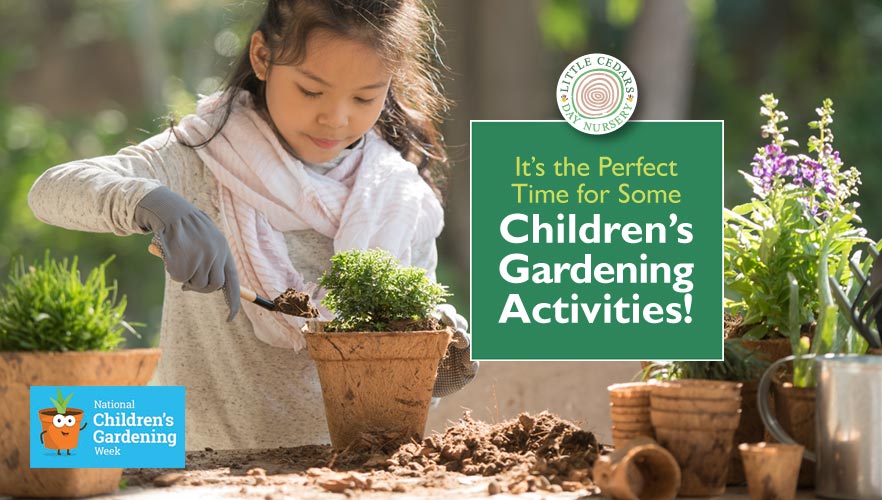
At the time of publishing this article, many UK children are enjoying National Children’s Gardening Week. At this time of year, the weather is sunnier more often, so it’s the perfect time to involve children in gardening activities. Whether taking part in the event or not, gardening is a fun, educational activity for children — and will also help to make the world a better place! So, if you would like to introduce your child to gardening and all that it has to offer little ones, read on as we tell you about some gardening activity ideas that little ones can take part in now and at any time during the warmer months of the year.
National Children’s Gardening Week
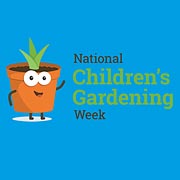 National Children’s Gardening Week takes place each year in the UK during what’s known as the ‘warm week’ beginning right at the end of May. This year (2024) it spans from 25 May to 2 June. However, children can get involved in gardening well outside of those dates*, of course.
National Children’s Gardening Week takes place each year in the UK during what’s known as the ‘warm week’ beginning right at the end of May. This year (2024) it spans from 25 May to 2 June. However, children can get involved in gardening well outside of those dates*, of course.
The annual gardening event for children started in the north of England but now takes place across the whole Nation and, like the plants and flowers in the gardens, its popularity is growing. Indeed, children are taking part at home, in schools, and at childcare settings like nurseries and preschools. In turn, the initiative itself supports the Greenfingers charity, which provides wonderful gardens and outdoor spaces for children in hospices.
* Children Can Garden Any Time in the Warmer Months
Late spring and the summer months in particular make things much easier for children to learn about gardening as there’s negligible chance of frost occurring. Warmer weather makes gardening easier and less complicated for them because, when it’s warm, there is no need to protect plants and seedlings from adverse weather conditions. What’s more, gardening results are much faster during the warmer months of the year, so even less patient children can remain engaged. That said, patience is something every child will have to learn, so a little waiting for results is a good lesson to learn.
Gardening Activities for Children
There are many fun gardening-related activities for children to do during the warmer months. Here are a few ideas to get children and families started.
Grow with Peter Rabbit Activities
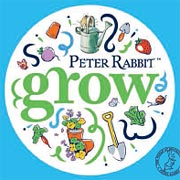 This year (2024), National Children’s Gardening Week has teamed up with The World of Peter Rabbit and is encouraging children and their families to Grow With Peter Rabbit! Free activity booklets for the initiative can be downloaded here. The dozen or so pages in this year’s activity booklet include 9 gardening-related activity ideas for children to take part in. Activities include anything from growing a windowsill herb garden and creating leaf-print cards to more simple tasks like solving garden-related pictorial puzzles. Download the activity booklet using the bold link above.
This year (2024), National Children’s Gardening Week has teamed up with The World of Peter Rabbit and is encouraging children and their families to Grow With Peter Rabbit! Free activity booklets for the initiative can be downloaded here. The dozen or so pages in this year’s activity booklet include 9 gardening-related activity ideas for children to take part in. Activities include anything from growing a windowsill herb garden and creating leaf-print cards to more simple tasks like solving garden-related pictorial puzzles. Download the activity booklet using the bold link above.
Wildflower Growing Activity
 A quick and easy outdoor activity for children is to sow and grow wildflowers (follow the bold link for much more information about this simple but worthwhile activity). Once growing and flowering, wildflowers will brighten up the garden and also attract important pollinators like bees and butterflies. What’s more, this activity is possible using just flower pots or grow bags on a patio or balcony if you don’t have access to a garden. You can also download our free butterfly reference poster for children here.
A quick and easy outdoor activity for children is to sow and grow wildflowers (follow the bold link for much more information about this simple but worthwhile activity). Once growing and flowering, wildflowers will brighten up the garden and also attract important pollinators like bees and butterflies. What’s more, this activity is possible using just flower pots or grow bags on a patio or balcony if you don’t have access to a garden. You can also download our free butterfly reference poster for children here.
Make Simple Bird Feeders
 Did you know, there are some incredibly easy ways for children to make home-made bird feeders? Follow our guide and you’ll soon see how children can make bird feeders from something as simple as a pine cone or even a recycled milk carton. Take a look via the link and get ready to welcome some lovely birds to your patch. Indeed, bird spotting is all part of the fun (download our free bird-spotting poster here).
Did you know, there are some incredibly easy ways for children to make home-made bird feeders? Follow our guide and you’ll soon see how children can make bird feeders from something as simple as a pine cone or even a recycled milk carton. Take a look via the link and get ready to welcome some lovely birds to your patch. Indeed, bird spotting is all part of the fun (download our free bird-spotting poster here).
Composting Activity
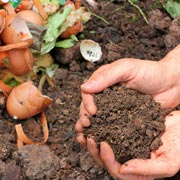 Composting is another hugely worthwhile activity for children to take part in, even right up into the Autumn. It’s easy and a great way to ecologically dispose of waste like egg shells, vegetable peelings, and garden waste like grass cuttings. What’s more, once complete, the household will have a ready supply of nutrient-rich compost that will enrich and feed flowers and plants in the garden or flower pots on the windowsill.
Composting is another hugely worthwhile activity for children to take part in, even right up into the Autumn. It’s easy and a great way to ecologically dispose of waste like egg shells, vegetable peelings, and garden waste like grass cuttings. What’s more, once complete, the household will have a ready supply of nutrient-rich compost that will enrich and feed flowers and plants in the garden or flower pots on the windowsill.
Minibeast Spotting
 Compost heaps are also wonderful homes for minibeasts, which are also fun and educational for children to spot. Use our previously published free Minibeast Reference Poster to learn how to recognise some of the common minibeasts that might be hiding in gardens, under pots, and in compost heaps around Britain.
Compost heaps are also wonderful homes for minibeasts, which are also fun and educational for children to spot. Use our previously published free Minibeast Reference Poster to learn how to recognise some of the common minibeasts that might be hiding in gardens, under pots, and in compost heaps around Britain.
Wildlife-Friendly Gardening
Try to teach your children how to make gardens wildlife-friendly (whether in back gardens or smaller spaces like patios and balconies). Ensure children understand that wildlife like bees and other flora and fauna are under threat from nasty chemicals and habitat loss. 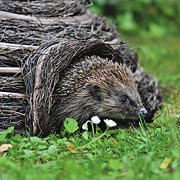 So, making a wildlife-friendly garden or area is a very worthwhile activity for children to take part in — and is educational on so many levels. See our separate guide to wildlife-friendly gardening for kids, try some of the ideas above, or download this free wildlife-friendly activity pack.
So, making a wildlife-friendly garden or area is a very worthwhile activity for children to take part in — and is educational on so many levels. See our separate guide to wildlife-friendly gardening for kids, try some of the ideas above, or download this free wildlife-friendly activity pack.
Indoor ‘Gardening’ Activities for Kids
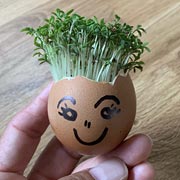 Children can do ‘gardening’ activities indoors too! Get them to try making egg cress heads, for example. It’s an easy, fun activity and children will love the results!
Children can do ‘gardening’ activities indoors too! Get them to try making egg cress heads, for example. It’s an easy, fun activity and children will love the results!
Did you know that children can also grow food from scratch indoors? They’ll love growing microgreens indoors and it can also be done on a windowsill. Not only will it be fun and educational for the children, but they’ll also be able to eat the results! Learn more about growing microgreens indoors here and learn more about the benefits of teaching children to grow food here.
More Gardening Ideas for Kids
More gardening-related activities for children can be found here. At the bottom of that page, you can also use the ‘older entries’ link to discover even more ideas.
Gardening is also a great way to introduce children to the concept of sustainability, ecological matters, and the need to protect both the environment and the planet as a whole. After all, we only have one planet and our children and grandchildren will eventually be in charge of its stewardship. Find out about some additional sustainable gardening activities that children can take part in here.
Why Gardening is Such a Worthwhile Activity for Children
 The benefits of gardening for children are many and varied and that’s why it’s such a wonderful activity to get them involved in. It will teach children many new skills and new knowledge. It’ll teach them about the circle of life, how to care and be responsible for other living things, and about the importance of looking after the planet. It will also give them an insight into where some food types come from. It is also great fun, will give children a huge sense of achievement, and may even open their eyes to the possibility of careers in horticulture, land management, food production, farming, and the like. And, of course, gardening makes the world a better place in so many ways. Let’s also not forget that being around nature is hugely beneficial to children, but do remember to follow good safety precautions when children are outdoors.
The benefits of gardening for children are many and varied and that’s why it’s such a wonderful activity to get them involved in. It will teach children many new skills and new knowledge. It’ll teach them about the circle of life, how to care and be responsible for other living things, and about the importance of looking after the planet. It will also give them an insight into where some food types come from. It is also great fun, will give children a huge sense of achievement, and may even open their eyes to the possibility of careers in horticulture, land management, food production, farming, and the like. And, of course, gardening makes the world a better place in so many ways. Let’s also not forget that being around nature is hugely beneficial to children, but do remember to follow good safety precautions when children are outdoors.
Little Cedars Nursery: First-Class Childcare in Streatham
Looking for the best childcare in Streatham or near Tooting, Furzedown, or Balham?

 Little Cedars Nursery also appreciates the importance of nature and outdoor play, so often engages children in such activities in our wonderful outdoor spaces. These include our own planting area where children can grow vegetables! The setting is a first-class nursery and preschool in Streatham and may also suit families nearby in Furzedown, Tooting, Balham, Norbury and Colliers Wood. A full early years education is available here for babies and under-fives, who are given all the tools and guidance they need to thrive once they leave us to begin at school. Government-funded childcare schemes are supported and the nursery is rated by Ofsted as a ‘Good Provider’.
Little Cedars Nursery also appreciates the importance of nature and outdoor play, so often engages children in such activities in our wonderful outdoor spaces. These include our own planting area where children can grow vegetables! The setting is a first-class nursery and preschool in Streatham and may also suit families nearby in Furzedown, Tooting, Balham, Norbury and Colliers Wood. A full early years education is available here for babies and under-fives, who are given all the tools and guidance they need to thrive once they leave us to begin at school. Government-funded childcare schemes are supported and the nursery is rated by Ofsted as a ‘Good Provider’.
So, if you’d like to give your baby, toddler, or preschooler the best start in life in the Streatham region, please get in touch today:

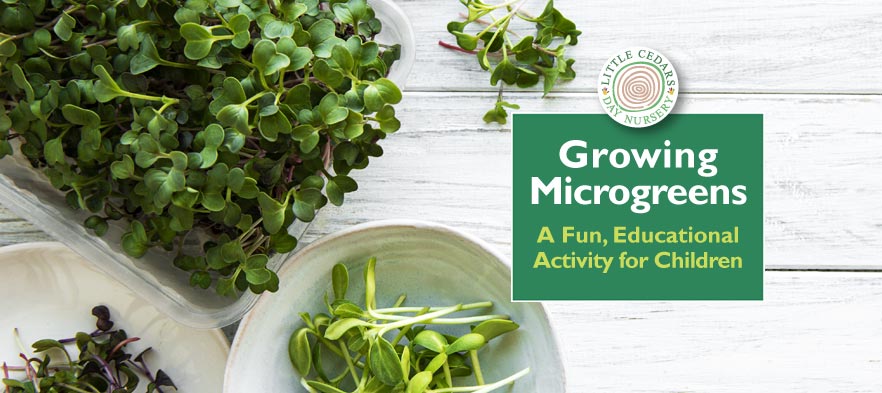
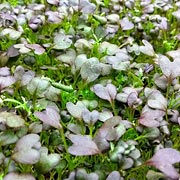 Back in April last year, we wrote an article about
Back in April last year, we wrote an article about 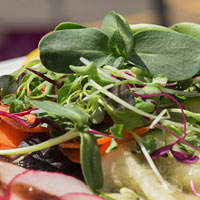 Microgreens are great fun and extremely easy for children to grow. Once ready, they can be used rather like salads and garnishes. They are very tasty and are extremely nutritious.
Microgreens are great fun and extremely easy for children to grow. Once ready, they can be used rather like salads and garnishes. They are very tasty and are extremely nutritious.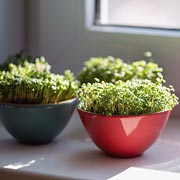 Microgreens are traditionally grown in shallow seed trays, which are inexpensive to buy. However, at home, they can just as easily be grown in flower pots, used yoghurt pots, empty egg cartons, the trays from ready-meals or even cut-down cardboard cores from kitchen rolls. So long as water is allowed to drain from them and they can support at least a shallow depth of compost, these can all be suitable. Plastic cartons will need a few holes punched in the bottom to allow for drainage, so parents might need to organise that in order to avoid their children hurting themselves. Other than that, it’s plain sailing for supervised children to do themselves.
Microgreens are traditionally grown in shallow seed trays, which are inexpensive to buy. However, at home, they can just as easily be grown in flower pots, used yoghurt pots, empty egg cartons, the trays from ready-meals or even cut-down cardboard cores from kitchen rolls. So long as water is allowed to drain from them and they can support at least a shallow depth of compost, these can all be suitable. Plastic cartons will need a few holes punched in the bottom to allow for drainage, so parents might need to organise that in order to avoid their children hurting themselves. Other than that, it’s plain sailing for supervised children to do themselves.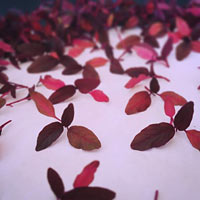 Suitable seeds include: rocket, a type of strongly-flavoured lettuce; beetroot, with their lovely red stems and mild, earthy taste; spinach, which also has a mild flavour and is full of goodness; red cabbage, which is also rich in a variety of vitamins and minerals; fennel, which will have a distinctive aniseed flavour; broccoli, which will grow into sprouts that have a slightly spicy taste; radish seeds, which also grow into leaves that taste a little fiery; and also mustard seeds (for children who are OK with even more hot, spicy flavours).
Suitable seeds include: rocket, a type of strongly-flavoured lettuce; beetroot, with their lovely red stems and mild, earthy taste; spinach, which also has a mild flavour and is full of goodness; red cabbage, which is also rich in a variety of vitamins and minerals; fennel, which will have a distinctive aniseed flavour; broccoli, which will grow into sprouts that have a slightly spicy taste; radish seeds, which also grow into leaves that taste a little fiery; and also mustard seeds (for children who are OK with even more hot, spicy flavours).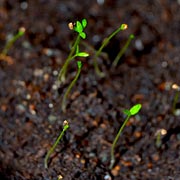 First, your child should fill the seed trays, flower pots or equivalent, almost to the top, with some compost.
First, your child should fill the seed trays, flower pots or equivalent, almost to the top, with some compost.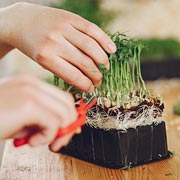 As as shoots begin to appear (usually after just a few days), remove any covering if used and continue to ensure that the compost is always kept moist, but not over-watered.
As as shoots begin to appear (usually after just a few days), remove any covering if used and continue to ensure that the compost is always kept moist, but not over-watered.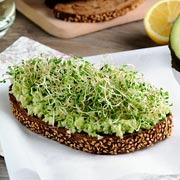 Once harvested, they should be rinsed to get rid of any stray compost. They are delicious to eat and, depending on the seeds grown, have a huge variety of tastes and colours. Children and parents alike can benefit from the nutritious and tasty shoots as part of a variety of meal types. Full of vitamins and minerals, they can be used in salads, as pizza toppings, garnishes, toppings for risottos, soups and pastas, as fillings in sandwiches, sprinkled on top of baked potatoes or into burgers and much more. They’re very adaptable and, with their distinctive tastes and textures, will make any meal really special.
Once harvested, they should be rinsed to get rid of any stray compost. They are delicious to eat and, depending on the seeds grown, have a huge variety of tastes and colours. Children and parents alike can benefit from the nutritious and tasty shoots as part of a variety of meal types. Full of vitamins and minerals, they can be used in salads, as pizza toppings, garnishes, toppings for risottos, soups and pastas, as fillings in sandwiches, sprinkled on top of baked potatoes or into burgers and much more. They’re very adaptable and, with their distinctive tastes and textures, will make any meal really special. Children will love growing these little edible plants and harvesting them for food. They will learn so much along the way, building to a great sense of achievement in what is a great home learning activity. Learning at home is just as essential as all the learning that takes place at nurseries like
Children will love growing these little edible plants and harvesting them for food. They will learn so much along the way, building to a great sense of achievement in what is a great home learning activity. Learning at home is just as essential as all the learning that takes place at nurseries like 